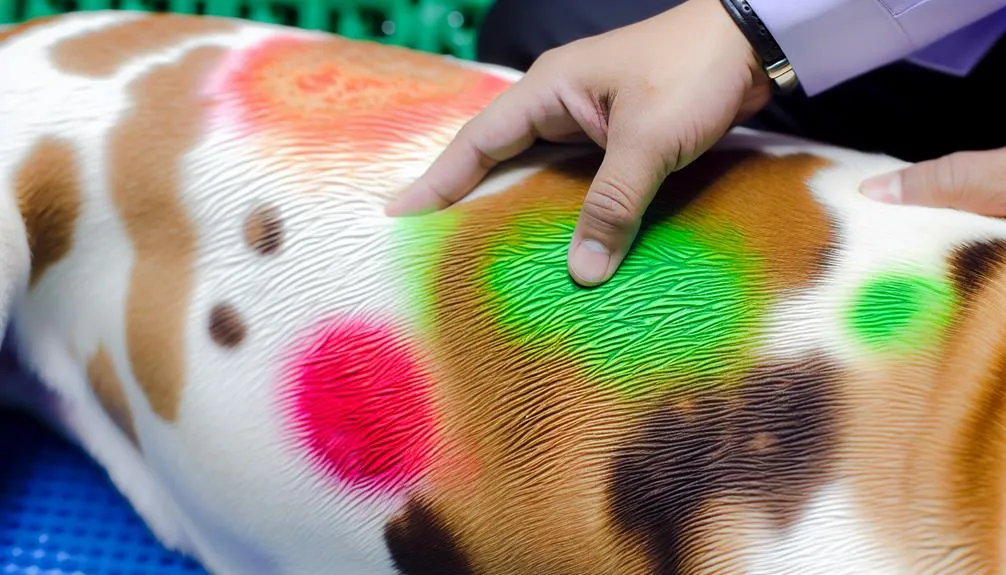
Does Food Coloring Irritate Dogs Skin
Have you ever wondered if that vibrant treat you give your dog could be causing more harm than good? While food coloring may enhance the visual appeal of pet snacks, it's worth considering how these additives might affect your dog's skin. Many pet owners overlook potential irritations that could arise from synthetic dyes, leading to discomfort and health issues. What are the signs to watch for, and how can you guarantee your furry friend stays safe and healthy when it comes to their diet?
Understanding Food Coloring
Food coloring is frequently used in a variety of products, from baked goods to pet food, to enhance visual appeal. These coloring agents are often synthetic or derived from natural sources, and they serve to make products more attractive to consumers. In pet food, the use of food coloring is particularly important, as it can influence a pet owner's perception of quality and freshness. However, while these additives may enhance appearance, it is vital to take into account pet safety.
When you look at food coloring, you'll find that not all coloring agents are created equal. Some are approved for use in human food but may not be safe for pets. Artificial dyes, like Red 40 or Yellow 5, can cause allergic reactions in some animals, leading to symptoms like irritation or gastrointestinal upset. Natural coloring agents, such as beet juice or turmeric, are generally regarded as safer, but they can still cause issues in sensitive dogs.
Before making decisions about what you feed your dog, it is important to read ingredient labels carefully. If you notice any artificial colors, it is wise to research their safety for pets. Consulting with a veterinarian can provide additional insights, especially if your dog has a history of skin irritations or allergies. Understanding the implications of food coloring not only aids in making informed choices but also guarantees that your furry friend remains healthy and happy.
Common Types of Food Dyes
When it comes to food dyes, you'll encounter two primary categories: natural food colorants and synthetic food dyes. Natural colorants are derived from plants and minerals, while synthetic dyes are chemically manufactured. Understanding the differences between these types can help you make informed choices about the foods you provide to your dog.
Natural Food Colorants
Natural food colorants are derived from various plant and animal sources, making them a popular choice for those seeking safer alternatives to synthetic dyes. These colorants come from natural sources like fruits, vegetables, and spices, providing a spectrum of hues without the risk of harmful chemicals. For instance, beet juice can produce a vibrant red, while turmeric yields a rich yellow color.
When you opt for natural food colorants, you'll find that ingredient safety is a significant advantage. Most plant extracts, such as spirulina and annatto, are regarded safe for consumption, and many are available as organic options. Additionally, the color intensity of these natural dyes can vary, so you may need to experiment with concentrations to achieve your desired shade.
One important aspect to take into account is dye absorption, as natural colorants can behave differently than their synthetic counterparts. Proper preparation and application are essential to guarantee that the colors adhere to your food items effectively. By choosing these natural alternatives, you're not only enhancing aesthetic appeal but also prioritizing your health and your pet's well-being.
Synthetic Food Dyes
Many people may not realize that synthetic food dyes are widely used in a variety of products, from snacks to beverages. While these synthetic dyes enhance visual appeal, their impact on dog health is a subject of concern. Some synthetic dyes have been linked to allergic reactions and skin irritations in dogs, which is why it's essential for you as a pet owner to be informed.
Here's a quick overview of some common synthetic food dyes:
| Dye Name | Common Uses | Potential Effects on Dogs |
|---|---|---|
| Red 40 | Candy, beverages | Allergic reactions, hyperactivity |
| Yellow 5 | Snacks, cereals | Skin irritations, stomach upset |
| Blue 1 | Ice cream, baked goods | Possible allergic reactions |
| Green 3 | Jellies, candies | Skin irritations, lethargy |
Understanding these synthetic dyes can help you make informed choices about your dog's diet. Always check labels for synthetic dyes, as they may contribute to skin irritations or other health issues in your furry friend. Prioritizing natural ingredients can promote better dog health and overall well-being.
Potential Skin Reactions

Dogs can exhibit various skin reactions to food coloring, which may range from mild irritation to more severe allergic responses. When exposed to certain dyes, you might notice that your dog experiences increased skin sensitivity. This could manifest as redness, itching, or even hives in some cases. The severity of these reactions often depends on the individual dog's tolerance to specific food colorants.
In general, the more exposure your dog has to these synthetic dyes, the higher the likelihood of developing an adverse reaction. Prolonged dye exposure can lead to cumulative effects, which may exacerbate any existing skin conditions. If your dog has a history of skin allergies or sensitivities, it's particularly important to monitor their reactions closely after consuming colored foods.
Some dogs may show immediate responses, while others could develop delayed reactions, complicating the assessment of the cause. Allergic responses can be triggered by specific compounds within the food coloring, such as azo dyes, which are commonly found in commercially prepared pet foods and treats.
If you suspect that your dog is reacting to food coloring, consider eliminating dyed products from their diet to observe any improvements in their skin condition. Always consult with a veterinarian for a thorough evaluation and to discuss appropriate dietary choices that minimize the risk of skin irritation related to food coloring. Identifying the right approach to your dog's diet can help in maintaining their overall skin health and well-being.
Identifying Symptoms of Irritation
When observing your dog for signs of skin irritation, it's essential to recognize common reactions such as redness, itching, or rashes. Additionally, look for indicators of allergic responses, like swelling or hives, which may require immediate attention. You should also monitor any behavioral changes, such as increased scratching or restlessness, as these can signal discomfort related to food coloring exposure.
Common Skin Reactions
Skin reactions to food coloring in dogs can manifest in various ways, making it crucial for pet owners to recognize the signs of irritation. One common symptom is redness on the skin, often indicating skin sensitivity to the dyes used in food products. You might also notice flaky or scaly patches, which can result from an allergic reaction to the coloring agents.
In some cases, itching and excessive scratching may occur, as your dog attempts to relieve discomfort. Be on the lookout for swelling in specific areas, which can signal a localized response to dye allergies. Additionally, hot spots—areas where the skin becomes inflamed and infected—can develop as a result of persistent irritation.
Some dogs may experience hair loss in affected regions, further hinting at a negative reaction to the food coloring. If you notice any of these symptoms, it's important to consult your veterinarian for a proper diagnosis and treatment plan. Prompt attention to these signs can help prevent more severe skin issues and guarantee your dog's well-being. Remember, early intervention is key in addressing skin problems related to food colorants.
Allergic Response Indicators
Recognizing the signs of an allergic response in your dog is vital for timely intervention. Dogs can exhibit various symptoms indicating skin sensitivity or an adverse reaction, particularly when exposed to food coloring or other allergens. It's important to observe your pet closely and be aware of the following indicators:
- Red or inflamed skin: Notice any areas that appear swollen or discolored, as this may signal irritation.
- Excessive scratching or biting: If your dog is scratching more than usual, it could be a sign of discomfort or an allergic reaction.
- Hot spots: These localized areas of skin irritation can become inflamed and painful, often requiring immediate care.
- Changes in coat condition: Look for unusual hair loss or changes in texture, which can indicate underlying skin issues.
If you suspect your dog is experiencing an allergic response, consider consulting with a veterinarian for allergy testing. This can help identify specific sensitivities and inform Treatment options. Early recognition and intervention can greatly improve your dog's comfort and prevent further complications.
Behavioral Changes to Watch
Watching for behavioral changes in your dog can help you identify symptoms of irritation that may be linked to food coloring or other allergens. Dogs often communicate discomfort through subtle shifts in behavior. Common stress indicators include excessive scratching, licking, or biting at their skin, which could suggest irritation.
You might also notice changes in their energy levels; a normally active dog may become lethargic or withdrawn. Similarly, signs of anxiety, such as pacing or hiding, can indicate that your dog is uncomfortable. Changes in appetite, like eating less or refusing food altogether, are also important behavioral changes to monitor.
Additionally, vocalizations—like whining or barking—may increase if your dog is experiencing irritation. Observe their interactions with you and other pets; a dog in discomfort might become more aggressive or irritable.
Being proactive about these behavioral changes can help you determine if your dog's symptoms are linked to food coloring or other allergens. If you notice any concerning behaviors, consult with your veterinarian for a thorough evaluation and appropriate Treatment options to help alleviate your dog's discomfort.
Factors That Influence Reactions

Taking into account the various factors that influence reactions to food coloring in dogs, it's essential to understand that individual sensitivities can vary greatly. Not every dog will respond the same way to food colorings, and several elements can affect their reactions. Here are four significant factors to take into account:
- Dietary Sensitivity: Some dogs may have specific dietary sensitivities that make them more prone to skin irritations when exposed to certain food colorings. These sensitivities can stem from pre-existing allergies or intolerances to particular ingredients.
- Individual Tolerance: Each dog has its unique threshold for tolerating various substances. What one dog can handle without issue may cause another to develop skin irritations or allergic reactions. Observing your dog's individual tolerance is important.
- Age and Health Status: Puppies and older dogs may have different sensitivities to food colorings compared to healthy adult dogs. Underlying health conditions can exacerbate reactions, making it important to take into account your dog's overall health.
- Type of Food Coloring: The composition of the food coloring itself can influence reactions. Natural colorings might be less likely to cause issues compared to synthetic ones, which often contain additional chemicals that could irritate sensitive skin.
Understanding these factors can help you make informed decisions about the foods you offer your dog. Always monitor your pet's reactions and consult a veterinarian if you notice any signs of irritation.
Alternatives to Food Coloring
When it comes to enhancing the appearance of your dog's food without the risks associated with artificial food coloring, there are several safe alternatives worth exploring. Natural coloring options can provide vibrant colors while being gentle on your dog's skin and digestive system.
One effective option is using pureed fruits and vegetables. For instance, beet juice can impart a deep red hue, while carrots offer a bright orange shade. Blueberries can create a pleasing blue tint, and spinach can be used for green. These options not only add color but also provide additional nutrients, making your dog's meals healthier.
Another safe alternative involves using spices and herbs. Turmeric, for example, can lend a golden-yellow color and has anti-inflammatory properties. Paprika can add a reddish hue, while spirulina offers a green color along with its rich protein content.
If you're looking for powdered options, consider using natural food powders derived from fruits or vegetables. These powders can easily blend into your dog's meals without the risk of irritation.
Always remember to introduce any new ingredients gradually to monitor for any adverse reactions. Opting for these natural coloring options guarantees that you're providing not only visually appealing meals but also safe alternatives that promote your dog's overall well-being. By choosing natural over artificial, you can help guarantee your furry friend stays happy and healthy.
Tips for Safe Pet Treats

To guarantee your furry friend enjoys treats that are both safe and nutritious, it is crucial to be mindful of the ingredients you choose. Many commercial pet treats contain additives and preservatives that can be harmful to your dog's health. Opting for homemade treats allows you to control what goes into your pet's snacks, ensuring ingredient safety.
Here are some tips for making safe pet treats:
- Select High-Quality Ingredients: Use whole, natural foods like fruits, vegetables, and lean meats. Avoid any ingredients that are toxic to dogs, such as chocolate, grapes, and onions.
- Avoid Artificial Additives: Steer clear of treats with artificial colors, flavors, or preservatives. These can cause allergic reactions or irritate sensitive skin.
- Monitor Portion Sizes: Even with homemade treats, moderation is key. Treats should only make up a small percentage of your dog's daily caloric intake to maintain a balanced diet.
- Check for Allergens: Be aware of any food allergies your dog may have. Common allergens include wheat, soy, and certain proteins. Always introduce new ingredients gradually and observe for any adverse reactions.
Frequently Asked Questions
Can Food Coloring Affect a Dog's Behavior or Mood?
Food coloring can potentially cause reactions in dogs, leading to behavioral changes. Some dogs may exhibit hyperactivity or lethargy depending on their sensitivity to certain dyes, so monitoring their behavior after consumption is essential.
Are Certain Dog Breeds More Sensitive to Food Coloring?
Think of dogs like unique flowers; each breed has different sensitivity levels. Some breeds may exhibit more sensitivity to food coloring due to genetic factors, leading to noticeable breed differences in reactions and overall health impacts.
How Can I Test My Dog for Food Coloring Allergies?
To test for food coloring allergies, observe symptoms after introducing new foods. Implement an elimination diet, removing potential allergens, then gradually reintroduce each item to identify specific triggers affecting your dog's skin or overall health.
Are Natural Food Colorings Safer for Dogs?
When considering natural food colorings, you should prioritize ingredient safety. Natural alternatives often pose less risk than synthetic options, but always consult your vet to determine what's best for your dog's unique sensitivities and health needs.
What Should I Do if My Dog Ingests Food Coloring?
If your dog ingests food coloring, don't panic! Watch for symptoms like vomiting or diarrhea. If they appear, your emergency response should be to contact your vet immediately for guidance and potential Treatment options.
Conclusion
In summary, while food coloring can enhance the appeal of treats, it might also lead to skin irritations in your dog. Imagine the joy of seeing your furry friend wag their tail, only to find them scratching in discomfort due to a dye allergy. By opting for natural colorants and monitoring your pet's reactions, you can guarantee their happiness and health. Remember, a little precaution goes a long way in keeping your beloved companion safe and vibrant.
You may also like
Archives
Calendar
| M | T | W | T | F | S | S |
|---|---|---|---|---|---|---|
| 1 | 2 | 3 | 4 | 5 | 6 | |
| 7 | 8 | 9 | 10 | 11 | 12 | 13 |
| 14 | 15 | 16 | 17 | 18 | 19 | 20 |
| 21 | 22 | 23 | 24 | 25 | 26 | 27 |
| 28 | 29 | 30 | ||||
Leave a Reply